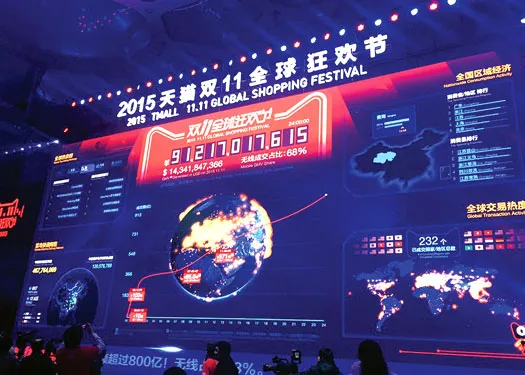
Singles' Day smashes records in China
Did China’s Singles’ Day turn out to be a huge windfall for online retailers this year?
Statistically, it was a phenomenal marketing success, far surpassing other similar online sales events like Cyber Monday in the US (which falls on the first Monday after Thanksgiving).
Known as the world’s biggest 24-hour online shopping event, Singles’ Day falls on November 11 every year, kicking off from the stroke of midnight. And this year, the Double 11 event saw its best performance ever.
Alibaba reported US$14.2 billion in sales on that day, up 60% from last year’s Singles’ Day and setting a new sales record for the e-commerce giant. JD.com also reported a stronger performance than last year, while smartphone brand Xiaomi said its sales hit a whopping US$188 million.
Even before the event commenced, a Nielsen survey showed that 56% of mainland Internet users were expected to spend more than last year.
Alibaba alone generated more than US$1 billion in sales within the first eight minutes of this year’s Singles Day, beating last year’s record of 17 minutes to hit the billion-dollar mark.
Buying apparently hit such a massive scale for some items such as milk powder that there were reports of it impacting markets outside of China. Australian company Bellamy’s had to apologise to customers Down Under after supermarket shelves there were emptied of milk powder. It was a shortage the company attributed on Facebook to “Chinese demand”.
JD.com also wrote on Twitter that orders for imported milk were up by 500% from last year.
Haoyu Shen, CEO of JD.com’s business-to-consumer group JD Mall, told CNBC that some of the most popular categories this year included consumer electronics, apparel and baby products.
Observers say the massive appeal of Singles’ Day reflects not only China’s penchant for online shopping but also the love Asians in general have for discount shopping and promotions.
Singles’ Day was created in the 1990s as a way to celebrate single life, but Alibaba was the first major company to monetise it, launching a special online sale in 2009 that effectively transformed the day into a shopping sensation.
First marketed as an “anti-Valentine’s Day”, featuring hefty discounts to lure singles and price-sensitive buyers, it has been hitting new highs each year and is now a huge and lucrative business opportunity embraced by the nation’s digital retailers.
This year, Alibaba, for example, launched its biggest marketing push for it, including using a three-hour TV special featuring numerous celebrities, including James Bond actor Daniel Craig and Hollywood star Kevin Spacey, to drum up consumer excitement.
The ploy clearly worked, sending Alibaba’s sales up tremendously, driven especially by mobile sales. Mobile accounted for nearly 74% — or US$2.9 billion — of total gross merchandise volume (GMV) in the first hour.
Alibaba also emphasised its focus on international e-commerce this Singles’ Day. “Within the next five years, we expect China will become the world’s largest e-commerce market for imported products,” Alibaba president Michael Evans told reporters.
Singles’ Day is definitely here to stay, but retailers may have to think more deeply about how they could make it more than just what it is now — a one-day phenomenon.
Said consultant Richard McKenzie, partner at global management consulting firm Oliver Wyman: “Singles’ Day was very successful overall, but some parties reaped more rewards than the others.
“The clear winners are consumers, marketplaces and couriers/delivery companies. However, for sellers and brand owners, the picture is less clear. While the event undoubtedly helped top line sales for some, some of those sales are not truly incremental.
“Additionally, GMV growth on Singles’ Day is much faster than overall GMV growth, meaning the pull forward effect could be exacerbated. In 2014, a significant proportion of sales were returned within 10-15 days.”
“Going forward,” said McKenzie, “sellers and brand owners need to carefully consider what they want to achieve from Singles Day — beyond a simple spike in sales. Leveraging the opportunity to increase brand awareness and consumer stickiness could make participation truly meaningful.”



















 Advertise
Advertise





